#this is a Nasikabatrachus frog
Explore tagged Tumblr posts
Photo


It’s true
14K notes
·
View notes
Text

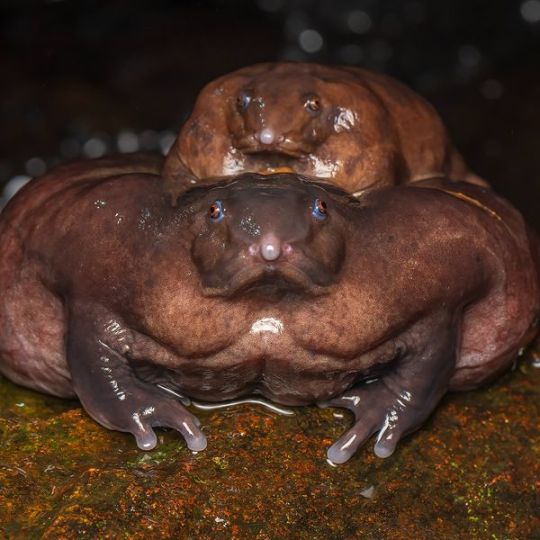
Purple Frogs (Nasikabatrachus sahyadrensis), mating, family Nasikabatrachidae, endemic to the Wesxtern Ghats of India
photographs by Dr Ashish Thomas
3K notes
·
View notes
Text
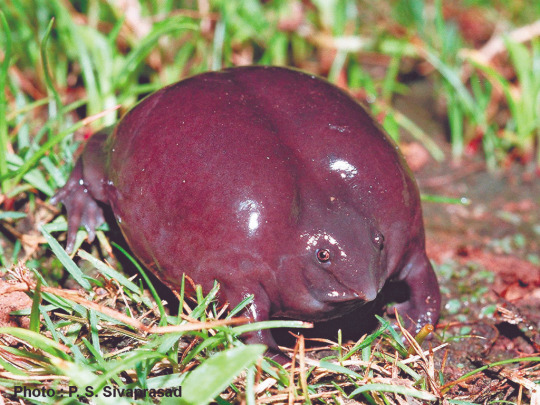
today's elegant frog of the day is the purple frog (Nasikabatrachus sahyadrensis)!!!!!!!!!!!!!!!!!!!!!! they're endemic to the western ghats mountain range and spend most of their lives underground! they are also, notably, rather purple.
photo by sivabirds!
1K notes
·
View notes
Note
I have a question. Out of all the amphibians you can think of, which have the most protuberant, goofy-looking, bug eyes? Like, I know most frogs and toads have pretty bulging eyes but there's gotta one or two species that take that up to eleven? Love your blog, it's a really nice mix of informative and fluffiness.
Oof, this is a tough one. Really had to give it some thought.
Purple frogs, Nasikabatrachus, have eyes that look like they have been glued onto a ball of clay:

Photo: Sandeep Das
But I feel like that's not what you're going for.
I think perhaps the most strikingly bulbous eyes belong to frogs of the genus Leptobrachium

[src] L. hendricksoni
These frogs have such huge heads—and then in those heads such huge eyes—that they really look like they were drawn by a cartoonist.
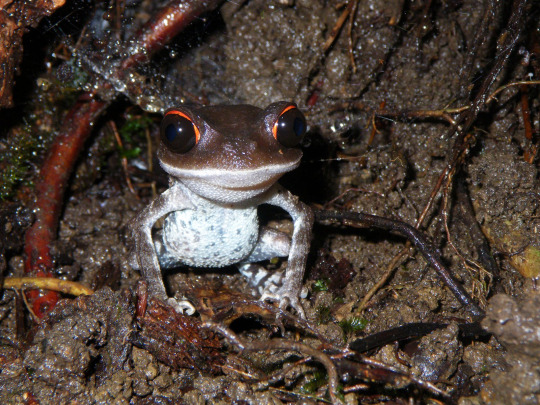
[src] L. lunatum
#frog#frogs#animals#zoology#herpetology#I feel like there are some out there that I am definitely not recalling right now#so please add to the list if you can#but Leptobrachium are pretty extreme#taking it to 11?#well maybe 10.5#Nasikabatrachus#Nasikabatrachus sahyadrensis#Leptobrachium#Leptobrachium lunatum#Leptobrachium hendricksoni#Answers by Mark
912 notes
·
View notes
Text
WAKE THE FUCK UP TUMBLR IT'S WORLD FROG DAY
LOOK AT THIS GUY:

Galaxy Frog (Melanobatrachus indicus): Vulnerable. Image credit: David V Raju CC BY-SA 4.0
AND THIS GUY:
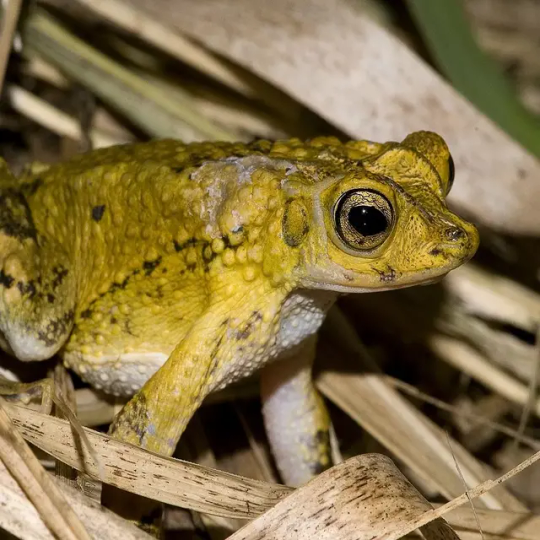
Puerto Rican Crested Toad (Peltophryne lemur). Endangered. Image credit: US FWS
AND THIS GUY:
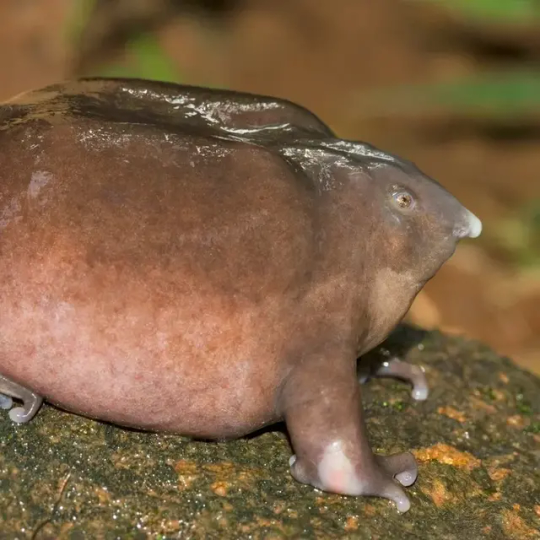
Indian Purple Frog (Nasikabatrachus sahyadrensis): Near Threatened. Image credit: Sandeep Das
We share our planet with over 7500 species of frogs and toads, but yet over a third of them are threatened with extinction due to human activity!
WE MUST PROTECT THESE FUNKY LIL GUYS
Check out the links below to learn about two endangered frog species and what YOU can do to help protect them from extinction!
Now, I shall commence the FROG BOMBING.
#animals#science#nature#biology#wildlife#conservation#environment#frogs#frogbombing tumblr for world frog day
280 notes
·
View notes
Text

frog bi pride flag!
featuring: Atelopus hoogmoedi Nasikabatrachus sahyadrensis Dendrobates tinctorius
#frogs#amphibian#amphibians#lgbt#pride#queer pride#lgbt pride#pride month#pride 2024#lgbtqia#happy pride 🌈#bisexual#pride flags#pride flag
21 notes
·
View notes
Text
10 Lesser-Known Animals and Their Unique Eating Habits 🦜🌿
Aye-Aye (Daubentonia madagascariensis)
Habitat: Madagascar 🌴
Diet: Insects, particularly wood-boring grubs 🪲
Feeding Habits: The aye-aye uses its long, thin middle finger to tap on trees to locate hollow chambers where grubs reside. Once a grub is located, it gnaws a hole in the wood with its forward-slanting incisors and uses its elongated finger to extract the grub. 🦷👆

Blobfish (Psychrolutes marcidus)
Habitat: Deep sea, off the coasts of Australia and New Zealand 🌊
Diet: Crustaceans, sea urchins, and other deep-sea creatures 🦀
Feeding Habits: The blobfish lacks muscles, so it doesn't actively hunt. Instead, it floats along the sea floor, opening its mouth to suck in any edible matter that drifts by. 🍽️

Pangolin (Pholidota)
Habitat: Various habitats across Asia and Africa 🌍
Diet: Ants and termites 🐜
Feeding Habits: Pangolins have long, sticky tongues that they use to probe ant and termite nests. They have strong claws to break into the nests and a sticky tongue to lap up the insects. 👅

Gharial (Gavialis gangeticus)
Habitat: Rivers in the Indian subcontinent 🌊
Diet: Fish 🐟
Feeding Habits: The gharial has a long, narrow snout filled with sharp teeth, perfect for catching fish. It uses a swift side-to-side snapping motion to catch fish swimming by. 🐊

Star-Nosed Mole (Condylura cristata)
Habitat: Wet lowland areas in North America 🦔
Diet: Small invertebrates, aquatic insects, worms 🪱
Feeding Habits: This mole uses its star-shaped nose, covered in sensory receptors, to detect prey. It can identify and consume small prey in a fraction of a second. 🌟

Hoatzin (Opisthocomus hoazin)
Habitat: Swamps, river forests of the Amazon Basin 🌳
Diet: Leaves and vegetation 🍃
Feeding Habits: The hoatzin has a specialized digestive system that ferments vegetation similar to a cow’s stomach. It spends hours digesting leaves in its crop, a part of its digestive tract. 🐦

Numbat (Myrmecobius fasciatus)
Habitat: Eucalyptus forests in Australia 🌏
Diet: Termites 🐜
Feeding Habits: Numbats use their long, sticky tongues to probe into narrow crevices and galleries within termite mounds. They can eat up to 20,000 termites a day. 👅

Leafcutter Ant (Atta spp.)
Habitat: Tropical rainforests in Central and South America 🌲
Diet: Fungi that they cultivate 🧫
Feeding Habits: Leafcutter ants cut leaves and carry them back to their nests, where they use the leaves to grow a special fungus, which serves as their primary food source. 🍄

Purple Frog (Nasikabatrachus sahyadrensis)
Habitat: Western Ghats of India 🌄
Diet: Termites 🐜
Feeding Habits: Spending most of its life underground, the purple frog comes out only during the monsoon season to breed. It uses its specialized tongue to feed on termites in underground colonies. 🐸

Vampire Finch (Geospiza difficilis septentrionalis)
Habitat: Galápagos Islands 🌴
Diet: Blood of other birds, insects 🌿
Feeding Habits: The vampire finch pecks at the skin of larger birds like boobies to drink their blood. This behavior likely evolved due to scarce food resources. 🦜

These lesser-known animals each have unique and fascinating feeding habits that highlight the incredible diversity of the natural world. 🌍✨
#animals#plants#forest#animal#wildlife#planet#nature#nature photography#naturelovers#natureconservation#animal protection#animal print#animal products
7 notes
·
View notes
Note
Oh oh lily lily how about 5 tropes you really like..... and your top 5 creatures ever. I wanna know
oh, that's an interesting question! ...
tropes (i see a pattern here)
mutual pining
there was only one bed
(childhood) friends to lovers
idiots in love (if they've got more than one braincell between them, what even is the point?)
hurt/comfort (with emphasis on the comfort pls)
honourable mentions: fake dating (the dumber the reasoning for it the better), everyone thinks they're dating but they're not, and putting characters from very wild(tm) settings into the most mundane situations possible
and creatures.... (there are so many, how am i supposed to choose?!!)
Bombylius major
Nasikabatrachus sahyadrensis (pls look this up, this is the frog i've ever seen)
world's fastest crouton (some kind of boxfish idk the species)
skinks. (they are so shaped. look at their tiny legs.)
this penguin specifically. (i feel so bad about how much this video makes me laugh, but everything about this is perfect. the thick german accent. the music. the script. i am in tears.)
honourable mention: himenui. (aka THE creature)
#lily answers#juu#i love sleepy intimacy i stand by that#and there are so many more creatures to love bc nature is so so wonderfully weird
5 notes
·
View notes
Text

Purple Frogs (Nasikabatrachus sahyadrensis), mating & laying eggs, family Nasikabatrachidae, Western Ghats, India
Photograph by Sandeep Das
420 notes
·
View notes
Text


Japanese Common Toad: Traditionally, these toads have had the venom from their glands used medicinally. In terms of behaviour, they hibernate underground over winter. When the temperature rises enough, in February/March, they undergo the migration to their breeding pools, using their sense of smell to find their way. They also eat an unpopular selection of insects including earthworms and carotid beetles, which are unsavoury due to the formic acid within them.
Indian Purple Frog: This species’ striking pointed nose is used to dig underground for their primary food source: termites, which they likely slurp up with their tongue. Not only eating there but also calling from under a layer of soil, they spend more time underground than most other burrowing frogs. They tend to only surface for mating during the rainy season. Tadpoles grow in quick-flowing streams, and have oral suckers to help them cling onto rocks. They are also used in traditional local medicine.
8 notes
·
View notes
Note
what's the stupidest/silliest looking frog you know of?
Oh
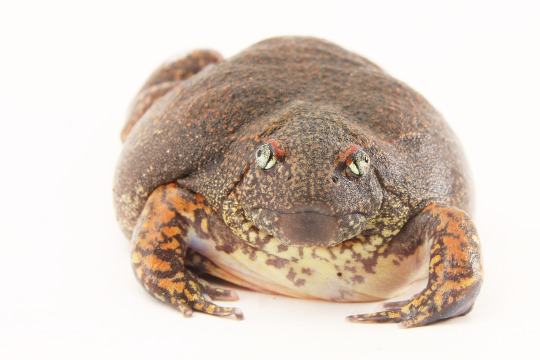
heck

that's
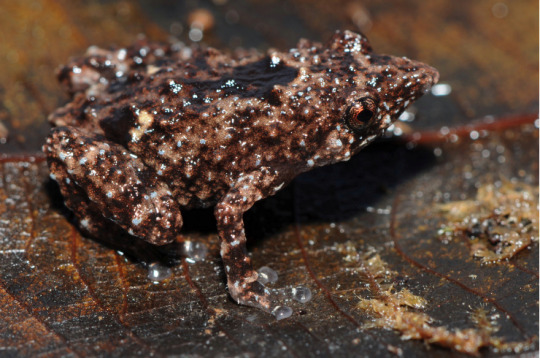
such
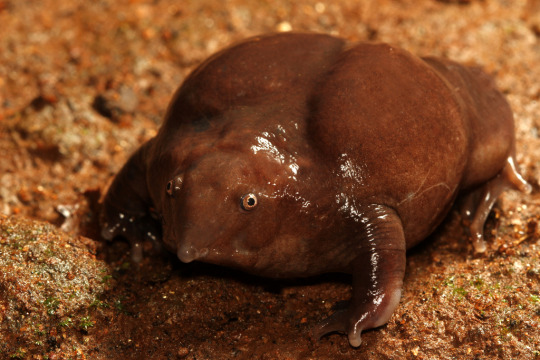
a

great

question
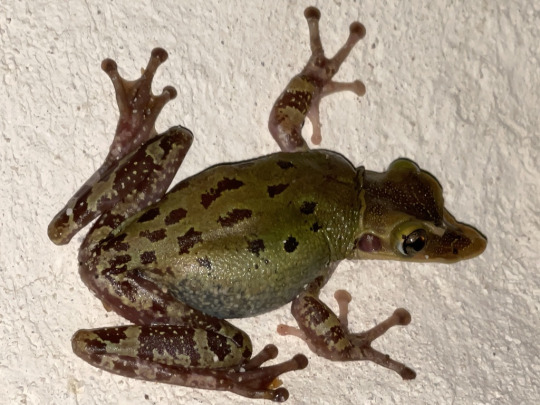
where
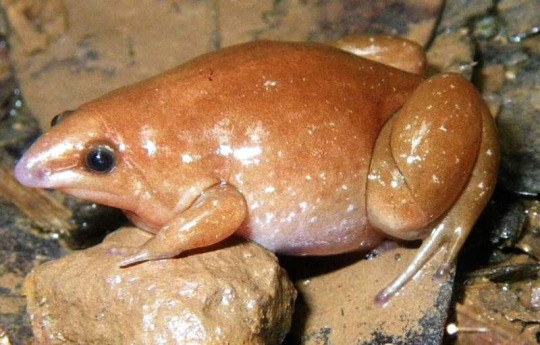
do

I
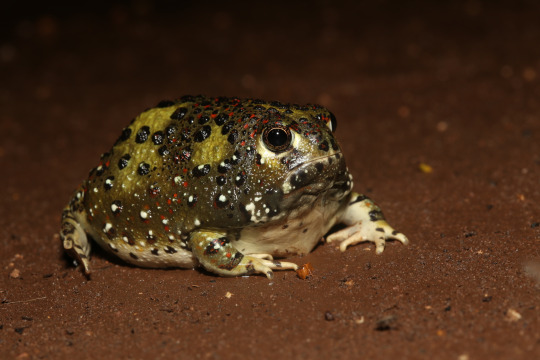
even
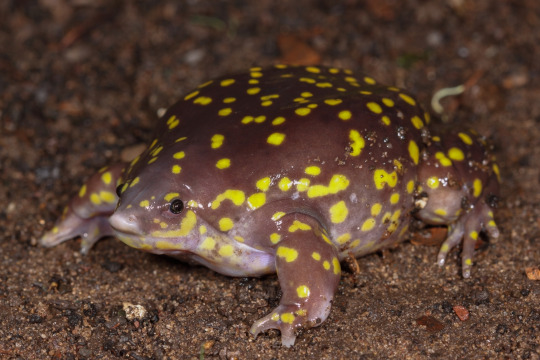
start?

[In order of appearance: Glyphoglossus molossus, Myobatrachus gouldii, Choerophryne proboscidea, Nasikabatrachus sahyadrensis, Pipa pipa, Litoria pinocchio, Triprion petasatus, Synapturanus danta, Breviceps verrucosus, Notaden bennettii, Hemisus guttatus, Hemiphractus bubalus]
#frogs#animals#wildlife#silly#biology#apparently there is a clear formula for a silly or stupid-looking frog#it should (1) be wider than it is long#(2) have something ridiculous going on with its snout#and (3) have bulging or otherwise hilarious eyes#I barely even had to TRY to come up with these goobers off the top of my head#I know for a fact that I missed dozens more weirdos#I mean#to be fair#have you ever really LOOKED at a frog?#like really looked at one?#they're ALL goobers#but also#and I cannot stress this enough#they're good frogs Brent#they're all good frogs
6K notes
·
View notes
Note
I know the answer to that frog question! It's nasikabatrachus sahyadrensis, the Indian Purple Frog!
UH. INDIAN PURPLE FROG?
5 notes
·
View notes
Text
Consider Art I: 2022
Happy Holidays! I hope everyone is having a pleasant holiday season and has recovered from blacking out from Thanksgiving gravy poisoning. This holiday season, I’d like to introduce a new tradition at Consider Nature. As you may know, Consider Nature is dedicated to shining a spotlight on some of the animal kingdom’s most underrated members, animals who get overlooked despite being fucking awesome. To help highlight the beauty of these funky little guys, I would like to introduce the first Consider Art Competition!
For Consider Art, artists are asked to create pieces depicting or inspired by an animal covered in the Consider Nature blog. For those who are not familiar with the blog, I have written articles on the following animals:
Olm (Proteus anguinus)
Indian Purple Frog (Nasikabatrachus sahyadrensis)
Pygmy Hippopotamus (Choeropsis liberiensis)
Scaly-foot Snail (Chrysomallon squamiferum)
Kaua’i Cave Wolf Spider (Adelocosa anops)
Shoebill (Balaeniceps rex)
Submissions will be judged based on their originality, quality, successful depiction of the animal, and whether or not the judges of the competition and I subjectively like it. All submissions are due JANUARY 6TH! Please check the submission guidelines below before entering your piece, as there is a specific process for entering a piece of art in this competition.
Prizes:
Here at Consider Nature, we are aware that exposure doesn't do a very good job of putting food on an artist's table. So, the top three art pieces submitted for the competition will receive prizes (they aren't going to be big prizes because I don't do this for money, but I'll do my best). The winning artists may choose to receive their prize as an Amazon or Etsy gift card (depending on how much they hate Jeff Bezos).
First place will receive a $50 Amazon or Etsy gift card.
Second place will receive a $25 Amazon or Etsy gift card.
Third place will receive a $10 Amazon or Etsy gift card.
All winning pieces will also be posted on the Consider Nature blog as well as on our social media (with full credit to the artists and links to their social media). Honorable mentions may also be awarded as part of this competition, depending on how many entries there are. These pieces will not receive a cash prize.
Submission Guidelines:
Any kind of art will be accepted for this competition. Keep in mind that if you make a physical drawing, painting, or sculpture, you will need to photograph or scan it to submit.
All submissions must be entered by January 6th, 2023. No entries will be considered after this time!
Please submit your piece as PDF, JPEG, or other common image file type. Pieces that cannot be opened by the judges on an average computer will not be considered.
To enter your piece into the competition, complete the following steps:
Email your submission to [email protected]
Post your submission on Instagram or Tumblr, using the hashtag #considerart2022.
When you post your piece, please provide a link to the Consider Nature article that corresponds to the animal represented in your piece. This will help other people find and enjoy Consider Nature.
Please make sure that you follow these submission guidelines, as improperly-submitted pieces may not be considered.
Rules:
Work submitted for this competition must be the artist's own original work.
Art made using AI tools such as DALL-E or Nightcafe will not be considered for this competition.
Pieces submitted must represent one of the animals covered in Consider Nature blogs.
Consider Nature has the right to reproduce pieces submitted for this competition on social media or on the Consider Nature website for the purpose of promoting the artist’s work or the Consider Nature blog. To be clear, pieces submitted for this competition will never be merchandised in any way without the artist’s express permission (and artists will be compensated).
#art#competition#considerart2022#animals#considernature#conservation#wildlife#nature#biology#zoology#science#ecology#cute animals#environment
75 notes
·
View notes
Text

frog asexual pride flag!
featuring: Leptobrachium lunatum Chiromantis xerampelina Phyllobates terribilis Nasikabatrachus sahyadrensis
#amphibians#amphibian#frogs#asexual#aroace#acespec#acesexual#ace#lgbt#pride#pride month#lgbt pride#lgbtqia#pride 2024#queer pride
6 notes
·
View notes
Text













Nasikabatrachus sahyadrensis, better known as the purple frog, Indian purple frog, or pignose frog is a species of burrowing frog in the genus Nasikabatrachus which is endemic to the Western Ghats in India. The frog spends most of its life underground near streams, creeks, pools, ponds, and wetlands, surfacing only for a period of 2 weeks during the monsoon season in order to mate. With few field scientists out in the field during the rainy season, the adult form of this species was only discovered and formally scientifically described in October 2003. However the Tadpoles had been described in 1917 by Nelson Annandale and C. R. Narayan Rao and thought to belong to a completely different species. Unlike many other burrowing species of frogs that emerge and feed above the ground typically at night, the purple frog forages for food whilst completely submerged and/ or buried feeding on a variety of termites, grubs, larvae, worms, crustaceans, and aquatic insects. Reaching around 1 to 3.5 inches (2.5 to 9cms) in length and 3.5 to 7 ounces (100 to 200grams) in weight, with males being typically around 1/3rd the length of the females, the purple frog sports a robust, bloated, rounded dorsoventrally flattened body. Their flattened body assists them to cling to submerged rocks and boulders which essentially helps them fight strong currents, allowing them to remain near stream banks where they typically reside. The arms and legs splay out in the standard anuran body form. Purple frogs have a small head with an unusually pointed snout. As the name suggests, adults are typically dark purplish-grey in color. During the monsoon season males emerge to call beside temporary rainwater streams. Females approach and then carry the males on their backs to the egg laying sites which are usually crevices along the fast-flowing streams. Here they will mate with mother purple frogs laying some 3000 eggs. The eggs soon hatch into tadpoles, which are mottled yellow and purplish brown with strong tails, broad heads and oral suckers which help them cling to rocks in the current. After 100 days the tadpoles fully metamorphose.
#pleistocene pride#pliestocene pride#cenozoic#amphibian#animal#facts#animal facts#purple frog#indian purple frogs#pignose frog
1 note
·
View note
Text

hognose snake (Heterodon nasicus)

aardvark (Orycteropus afer)

greater hog badger (Arctonyx collaris)

hog-nosed skunk (Conepatus humboldtii)

pig-nosed turtle (Carettochelys insculpta)

sulawesi snouter (Hyorhinomys stuempkei)

pignose frog (Nasikabatrachus sahyadrensis)

kitti's hog-nosed bat (Craseonycteris thonglongyai)
I could and would go on, except the nurse has arrived with my sedative.
My favorite genre of creature is anything hog-nosed 🐽
546 notes
·
View notes